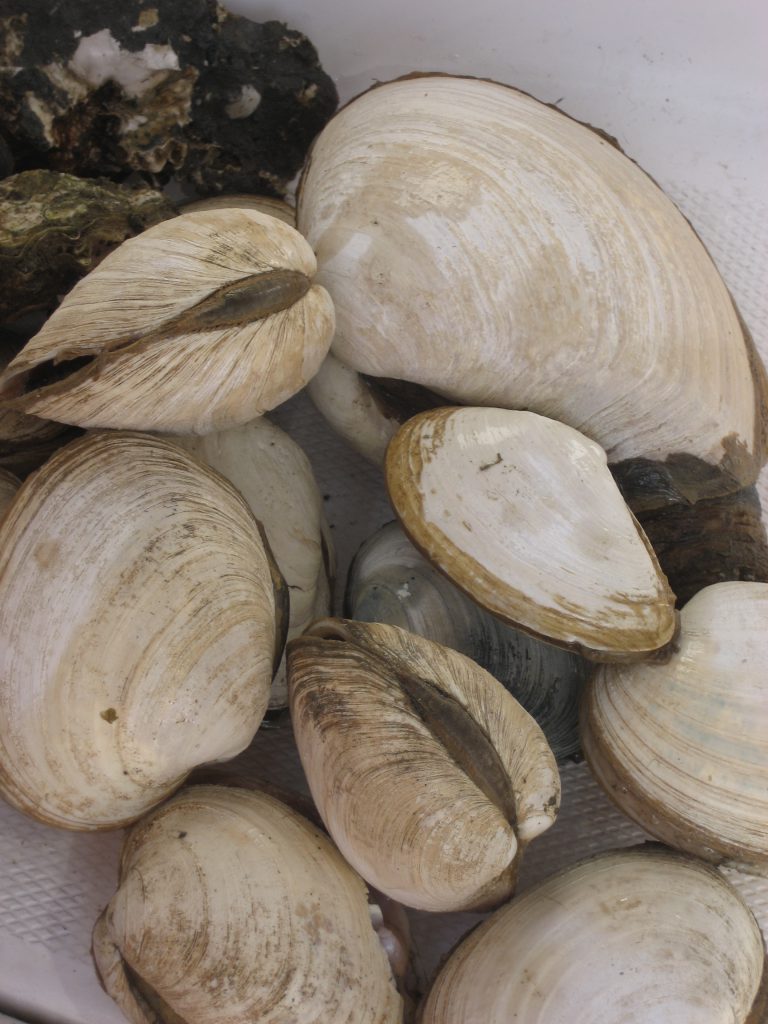What Clam Thermometers Tell Us About Past Climates
It’s mid-August, 2017, but the temperature in Unalaska, one of the Aleutian Islands that trails off of the western Alaskan coast, is a brisk 50 degrees Fahrenheit. Christine Bassett, a graduate student in geology at the University of Alabama, is preparing to dive in the 40-degree water of Amaknak Spit. Protected by a Neoprene dry suit and laden with nearly a hundred pounds of scuba gear, Bassett hopes her dive will yield live butter clams—an unlikely key to understanding patterns of human behavior thousands of years in the past.
At first glance, the butter clam (Saxidomus gigantea) is an unassuming bivalve. Found in the Pacific Ocean from Alaska down to central California, butter clams are large—up to 5 inches across—and have a bulky shell tinted a buttery yellow. Prized as a food, they’re dug commercially and for sport, and in some places they are farmed. However, wild butter clams can pose a significant hazard to those who wish to consume them, because they sometimes absorb harmful toxins from the algae they eat, and a small amount can prove deadly. (In warmer water, the algae containing these toxins will often “bloom,” increasing rapidly and immensely in population size, meaning that the clams absorb a lot more of the toxin. It is when these blooms occur that the clams can become lethal.)
Hundreds of butter clam shells appear in the middens, or trash heaps, of archaeological sites on Unalaska, indicating that the local inhabitants regularly made meals of the clams. It is possible that the waters around the Aleutians were cold enough to prevent harmful algae blooms, or perhaps the food was worth the risk. Understanding ocean temperatures and their effects on the people of the Aleutians is the key focus of Bassett’s work.
The part of the butter clam that is most interesting to geologists like Bassett—and the archaeologists with whom she collaborates—is the shell. As they grow, butter clams absorb carbon and oxygen isotopes from the water and incorporate them into their shells. The percentages of these isotopes in the water shift as temperatures fluctuate. Therefore, as the clams build their shells, they produce a record of the temperature of the water surrounding them.
Sampling the butter clam shells for isotope testing is an extremely delicate process. To extract the information she needs from the clams, Bassett drills along the growth lines of each butter clam shell with a half-millimeter bit. She then transfers the microscopic amount of shell dust to a vial for testing. A single ill-timed breath, wobble, or sneeze could destroy a sample.
Bassett will use the modern butter clams she collects on her dives, along with modern water temperature data from Unalaska, to calibrate the isotopes in the modern clam shells with water temperature. She will use this calibration—which researchers sometimes refer to as a “clam thermometer”—to calculate water temperatures from the clam shells found in ancient middens.
Bassett’s work to understand water temperature and climate around the Aleutian Islands is an important part of the Unalaska Sea Ice Project (USIP). Archaeologists have known for years that the remains of sea-ice loving mammals (bearded seals and ringed seals) are present at three sites on Unalaska: Margaret Bay, Amaknak Bridge, and Amaknak Spit.
However, sea ice has never been recorded as far south as the Aleutian Islands. USIP researchers want to use new methods to understand whether the presence of these animals indicates a dramatic landscape change or a change in the behavior of the animals themselves.
The USIP archaeological sites were intermittently occupied between 4,700 and 350 years ago, and there is no record of the climate conditions during that period. While there is some historical record of the lives of the Unangan, the Indigenous people of the Aleutian Islands, it does not extend much further back than the late 18th century—when Russian Orthodox missionaries first entered the region.
The majority of what we know about the Unangan comes from oral histories and from archaeology. Oral traditions, combined with artifacts such as bone tools, harpoon points (which would have been used for seal hunting), and knapped stone blades, can tell us a certain amount about how the early Unangan lived their daily lives, but archaeologists still have many questions. Oral histories and ongoing traditions indicate that the Unangan traditionally hunted seals, whales, and other marine mammals on the open water, from kayaks. If sea ice formed around Margaret Bay, Amaknak Spit, and the Amaknak Bridge site, the Unangan may have been forced to switch from open-sea hunting to hunting on coastal ice.
A thousand years in the future, if someone were to sort through everything you threw away, what could they understand about how you lived your life?
Archaeologists want to know whether the Unangan shifted to this method of hunting at any point on Unalaska. Bassett’s research will determine whether ocean temperatures could have been cold enough for ice to form. Once the USIP team understands the environment that would have surrounded the three sites during the times that they were occupied, they will have a context in which to understand the archaeological material from the sites.
Although patterns of seal hunting and other sea-ice related behavior remain open questions, the USIP archaeologists can currently reconstruct some of the Unangan people’s diet based on the midden material from the archaeological sites. Fish bones show that the Unangan fished for cod and halibut in the open Bering Sea and for salmon in the many waterways that cross Unalaska. Shell material shows that the Unangan also gathered mussels, sea urchins, and, of course, butter clams. All of these foods are still harvested by the modern descendants of the Unangan, who live on Unalaska today.
The equivalent of a local trash heap has proved to be the most important record of daily life in a unique environment. To truly appreciate the importance of the midden material, imagine that all remnants of your life except your weekly garbage have disappeared. A thousand years in the future, if someone were to sort through everything you threw away, what could they understand about how you lived your life?
If Bassett’s work with the USIP is any indication, the answer is “probably quite a bit.” Her research on the “clam thermometer” will be combined with all of the other information gleaned from the archaeological artifacts and animal remains to re-create the life history of a group of people thriving in a unique and challenging landscape—and maybe even to tell us how they adapted to the drastically different climates they faced over the course of millennia.

































